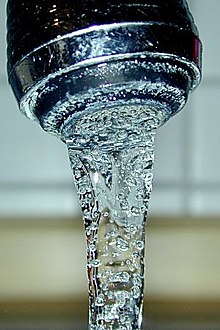A liquid is a form of matter. It is settled between solid and gas. Liquid has an almost-fixed volume, but no set shape.[1]

Every small force makes a liquid change its shape by flowing. Because of that, gravity makes liquids always take the shape of the container. The molecules that make up the liquid can freely move among themselves.[2]
Fluids that flow slowly have a high viscosity.[3] Some fluids like tar have such a high viscosity that they may seem solid.[4]
It is difficult (near impossible) to compress a liquid. If a liquid is cooled down until it is colder than a certain temperature, it will become a solid. This temperature is called the melting point or freezing point and is different for every different type of liquid. If a liquid is heated up it becomes a gas. The temperature this happens at is called the boiling point.
Examples of liquid are water, oils, tar and blood.
In a liquid, the liquid on the top presses down on the liquid underneath, so at the bottom the pressure, p, is bigger than at the top. The equation for working this out is:
- p = ρgz
where z is the depth of the point below the surface and g is how strong gravity is pulling on the liquid. ρ is a number that tells us how heavy a set amount of the liquid is. We call this the density and it is different for all liquids.
References
Other websites
Wikiwand in your browser!
Seamless Wikipedia browsing. On steroids.
Every time you click a link to Wikipedia, Wiktionary or Wikiquote in your browser's search results, it will show the modern Wikiwand interface.
Wikiwand extension is a five stars, simple, with minimum permission required to keep your browsing private, safe and transparent.
